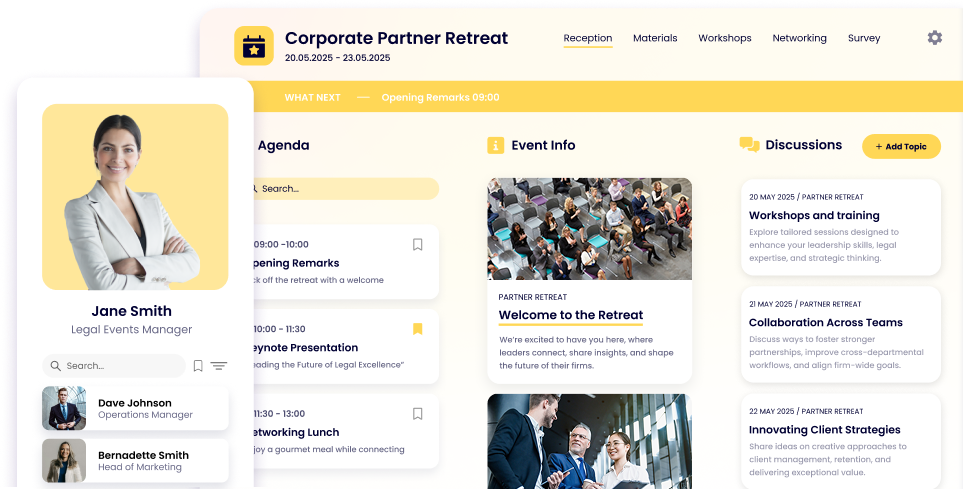How to Set Up QR Code Check in to Speed Up Attendee Check-in

Lisa Broom | Head of Marketing

It’s a way to generate unique tickets, offer effortless entry and exit, and create touchpoints for insightful data.
Sounds incredible but also complicated, right?
Luckily, this technology is well within your grasp. Tools like Fliplet allow you to have a fully customized QR code event check in app without having to a hire a tech team.
Let’s get into it all with this ultimate guide to QR code event check ins.
Key Takeaways
- Efficiency Boost: QR code check-in systems streamline attendee entry, reducing wait times.
- Enhanced Experience: Offers a contactless, user-friendly experience for attendees.
- Data Collection: Real-time analytics and data sync improve event management and post-event analysis.
- Customization: Easy to tailor to specific event needs, including badge design and app integration.
What Is an Event Check-In QR Code and Why Do They Improve Attendee Check-In?
A QR code, or Quick Response code, is a two-dimensional barcode that can be scanned using a smartphone camera or a dedicated QR code reader app. These codes have become ubiquitous in various applications, from advertising to product packaging, due to their ability to store a significant amount of information in a compact form.
With an event check in QR code, this tool streamlines the entire process, providing a modern and efficient alternative to traditional paper tickets or manual entry methods.
Organizations and companies use QR code event check in systems because of their:
Speed:
- Instant Scanning: QR codes can be scanned in seconds, allowing for quick verification of each attendee’s credentials.
- Reduced Wait Times: Faster check-in means shorter queues, which improves the overall attendee experience and sets a positive tone for the event.
Accuracy:
- Eliminates Manual Entry Errors: By automating the check-in process, QR codes significantly reduce the risk of human error associated with manual data entry.
- Real-Time Updates: As attendees are checked in, the system can be updated in real-time, ensuring accurate attendance records and capacity management.
Convenience:
- Seamless Process: Attendees can simply show their QR code on their smartphone, eliminating the need for paper tickets or remembering physical passes.
- Easy Access: With QR codes integrated into an event app, attendees have all their event information in one place, including schedules, maps, and networking opportunities.
Environmentally Friendly:
- Reduces Paper Waste: By adopting digital check-in processes, QR code event check-ins significantly reduce the amount of printed materials, contributing to a more sustainable event model.
- Lower Carbon Footprint: The production and disposal of paper tickets involve a considerable carbon footprint, which can be minimized by using digital alternatives like QR codes.
Enhanced Security:
- Secure Access: Event QR code check in can be encrypted and generated uniquely for each attendee, ensuring that only registered participants gain entry to the event.
- Fraud Prevention: The use of dynamic QR codes that expire or are invalid after use helps prevent unauthorized access and ticket fraud.
Improved Data Collection:
- Comprehensive Insights: The data collected through QR code check-ins can provide valuable insights into attendee behavior and preferences, aiding in post-event analysis and future planning.
- Integration with Other Systems: QR codes can be integrated with other event management systems, allowing for seamless data sharing across platforms for a comprehensive overview of event operations.
How Do You Use a QR Code to Check In Guests at Your Event?
Using a QR code for event check-in is simple and effective. Here’s a quick guide to get you started:
- Create Your QR Code: Use a QR code generator to create unique codes for each attendee. This can be done through Fliplet’s event app, which streamlines the process. (Note: if this is your first time using Fliplet, you can create your QR code event check in free.)
- Distribute Codes: Send the QR codes to attendees via email or through an event app.
- Set Up Scanning Stations: At the event, set up multiple check-in points equipped with devices or kiosks capable of scanning QR codes.
- Train Staff: Ensure your staff is familiar with the QR code check-in process and the event app features.
How to Use Fliplet for QR Check-In
Fliplet’s platform offers a user-friendly solution for managing event check-ins with QR codes. Plus, if this is your first app using the platform, your can even get a free QR code event check in. Here’s how you can utilize Fliplet for your next event:
Add Your Attendees

- Simple Setup: Import attendee lists into Fliplet to generate personalized event check in QR codes.
Give Your Staff Access to the QR Code Event Check-in App

- Streamlined Access: Ensure all staff members have access to the Fliplet app to manage check-ins efficiently.
Email QR Code Event Check-In
- Easy Distribution: Use Fliplet to email QR codes directly to attendees, ensuring everyone has access to their code.
Customize Your Check-In Process
- Tailored Experience: Adjust the check-in process to meet your event’s specific needs, such as adding custom fields or integrating with other tools.
Use the Onsite App to Manage Check-Ins

- Real-Time Management: Use Fliplet’s onsite app for real-time QR code event check-in management and analytics.
How to Scan a QR Code from Your Phone

Getting an event QR code check in to work is a straightforward process that can be done using most smartphone cameras.
Here’s a step-by-step guide on how users of different devices can easily scan QR codes at your event:
iPhone Users
- Unlock Your iPhone:
- Wake up your iPhone and unlock it using Face ID, Touch ID, or your passcode.
- Open the Camera App:
- Locate the Camera app on your home screen or use the Control Center.
- Swipe down from the top-right corner of the screen (for iPhones with Face ID) or swipe up from the bottom (for iPhones with a Home button) to access the Control Center and tap the Camera icon.
- Point at the QR Code:
- Hold your iPhone steady and point the camera at the QR code. Make sure the code is within the camera’s frame and is well-lit.
- Scan and Access Information:
- Wait for a notification banner to appear at the top of the screen. This banner will show a preview of the link or action associated with the QR code.
- Tap the notification banner to open the link or perform the action.
Android Users
- Unlock Your Android Phone:
- Wake up your phone and unlock it using your fingerprint, PIN, pattern, or facial recognition.
- Open the Camera App:
- Locate the Camera app on your home screen or in the app drawer. Most Android phones have a shortcut to the Camera app on the lock screen for quick access.
- Point at the QR Code:
- Hold your phone steady and aim the camera at the QR code, ensuring it fits within the frame.
- Scan and Access Information:
- Look for a notification or a small pop-up at the bottom of the screen showing the link or action related to the QR code.
- Tap the notification or pop-up to proceed.
- Dedicated QR Code Scanning Apps (if needed):
- If your Camera app does not support QR code scanning, download a dedicated QR code scanner app from the Google Play Store. Popular options include QR Code Reader, QR & Barcode Scanner, and others.
- Open the scanning app, point it at the QR code, and follow the prompts to access the link or action.
Additional Apps
- Event Apps and Browsers:
- Many modern apps, including Fliplet, have built-in QR code scanning features. These apps often provide added functionality specific to the event, such as displaying event information, schedules, or personalized content.
- Web browsers like Google Chrome also have QR code scanning capabilities. On Chrome, tap the address bar and then the QR code icon to start scanning.
10 Ways QR Codes Speed Up Event Check-In

QR codes can significantly enhance the efficiency of your event’s check-in process. Here are nine ways they make a difference:
1.Automated Entry
- Swift Check-In: Scan codes to instantly verify attendee credentials, speeding up the entry process.
2.Pre-Event Registration
- Early Registration: Allow attendees to register and receive their QR codes in advance, reducing bottlenecks at the venue.
3.Multiple Check-In Points
- Flexible Access: Set up several check-in stations to manage large crowds efficiently.
4.Self-Service Kiosks
- Empower Attendees: Enable self-service check-in kiosks for attendees to scan their QR codes without staff assistance.
5.Real-Time Data Sync
- Seamless Integration: Synchronize attendee data across all platforms in real time for accurate tracking and reporting.
6.QR Code Event Check-In System
- Comprehensive Solution: Utilize a system like Fliplet to manage check-in and gather valuable feedback using the real-time feedback app.
7.Quick Badge Printing
- On-the-Spot Badges: Print badges instantly as attendees check in, saving time and resources.
8.Contactless Check-In
- Health & Safety: Provide a safe, contactless experience, essential in today’s health-conscious world.
9.Instant Verification
- Efficient Processing: Confirm attendance quickly with instant QR code scanning and verification.
10.Integrated QR Code Event Check-In App
- All-in-One Management: Fliplet’s app integrates with other event management tools, providing a seamless experience from check-in to feedback collection. This integration ensures that all aspects of your event are connected, making it easier to manage attendee data, track engagement, and gather insights in real time.
- Choosing the Right Event App: When selecting an event app, consider factors such as ease of use, compatibility with your existing systems, and the ability to customize features to fit your specific event needs. Look for apps that offer robust support, regular updates, and positive user reviews to ensure reliability and a smooth event experience.
Tips for Designing Badges for QR Code Check-In
Creating effective badges is essential for a successful event QR code check-in experience.
Here are some tips:
Make Them Visible at a Distance
- Clear Display: Ensure badges are large enough to be seen from a distance, aiding in easy identification.
Include Your Event Logo
- Brand Recognition: Add your event logo for a professional touch and brand consistency.
Include Your Event Title
- Event Clarity: Clearly display the event title to help attendees remember where they are.
Brand Your Badges
- Consistent Branding: Use consistent colors and fonts to match your event’s branding.
Add the Schedule
- Helpful Information: Include a schedule or agenda on the badge for easy reference.
Add the Map
- Navigation Aid: Provide a map of the venue to help attendees navigate the event space.
Add Networking Prompts
- Encourage Interaction: Include prompts or questions to encourage networking among attendees.
Keep It Simple
- Clutter-Free Design: Avoid overcrowding the badge with too much information.
Remember, if you want to get the most out of QR code event check ins, you’ll want to track the information you generate. This requires a data collection app (Fliplet can put all of this in a single place). It’s a tool that offers customizable forms, user-friendly experiences, and real-time access to the data you are collecting.
Transform Your Events: How to Create & Set Up Free QR Code Event Check-In with Fliplet
Using Fliplet’s platform for QR code check-ins not only simplifies the process but also enhances the overall attendee experience. Our easy-to-use tools allow you to create, distribute, and manage QR codes with minimal effort. With Fliplet, you’re not just improving your check-in process; you’re transforming your entire event experience.
Want to try it for free?
FAQs
How can I set up a QR code event check-in for free?
With Fliplet, you can easily create and set up a QR code check-in system at no cost by signing up and using our event app builder.
What are the steps to email a QR code for event check-in?
Simply generate QR codes through Fliplet and use the platform to email them directly to your attendees.
What features should I look for in a QR code event check-in system?
Key features include real-time data sync, contactless check-in, multiple check-in points, and integration with event management tools.
What are the benefits of using a QR code for event check-in?
QR codes offer a faster, more accurate, and environmentally friendly check-in process that enhances the attendee experience.
How can I track attendance using a QR code event check-in system?
Utilize Fliplet’s real-time analytics to monitor attendance and gather valuable insights throughout your event.
Is it possible to use QR codes for contactless event check-ins?
Yes, QR codes provide a contactless, safe option for check-ins, reducing the need for physical contact and printed materials.
How do I generate a QR code for my event?
Sign up with Fliplet, input your attendee information, and generate unique QR codes for each participant through our platform.




